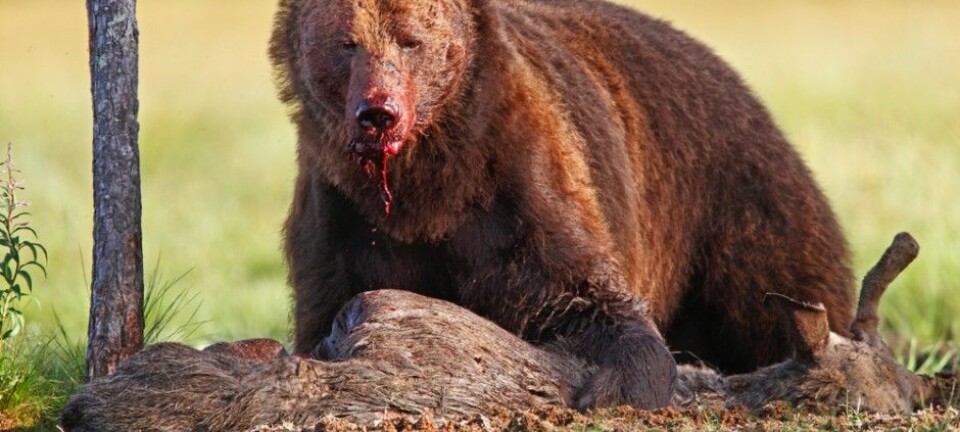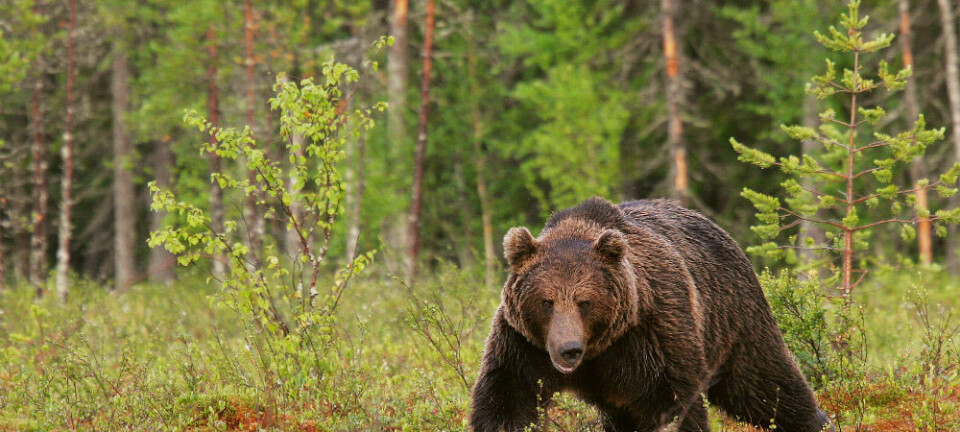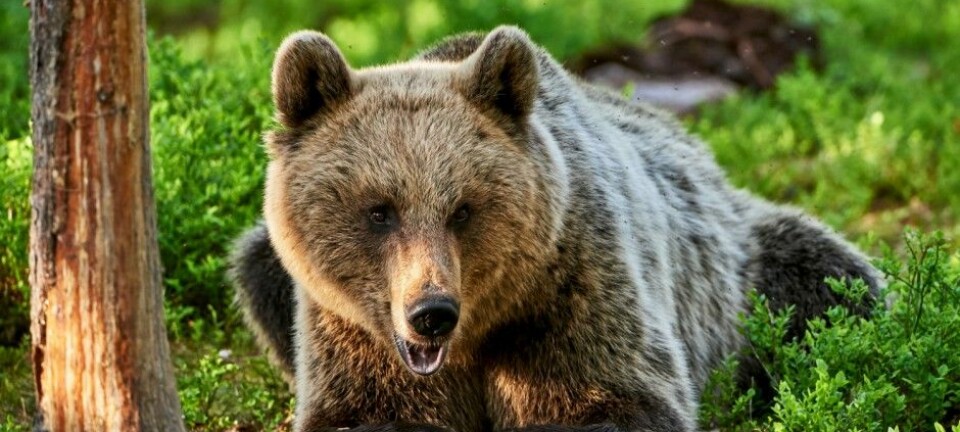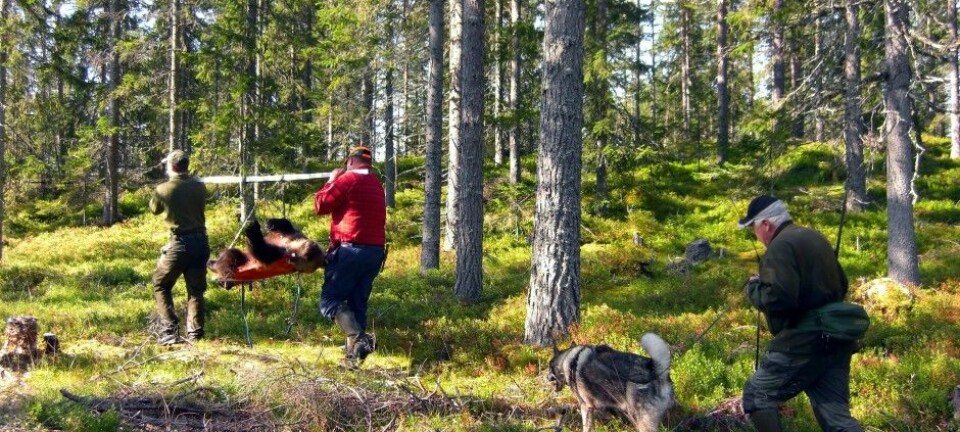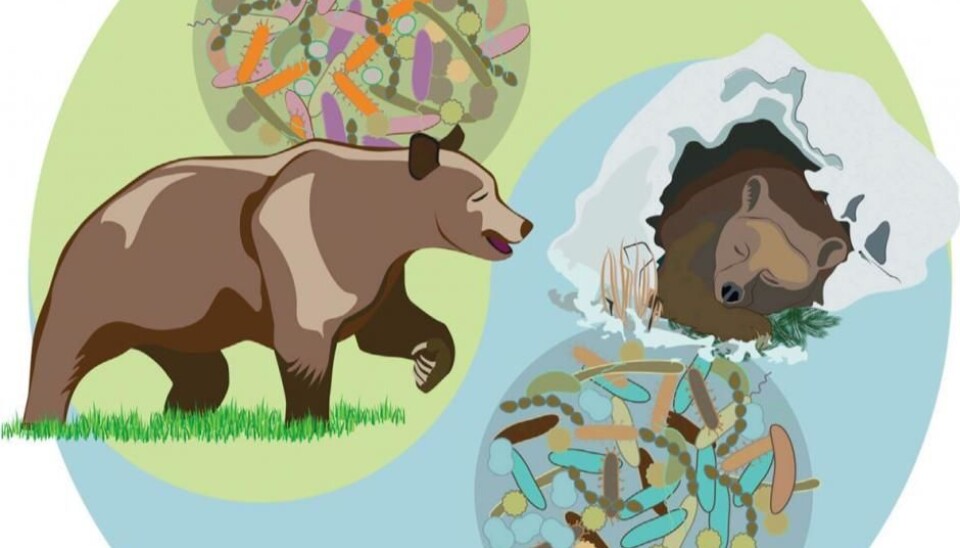
Gut bacteria keeps bears healthily obese
Brown bears are obese. They have to be to survive months of hibernation. And yet they do not experience the complications that we do when we pile on the pounds. So what can they teach us?
The summer sun pokes its way through the pine trees to strike the forest floor, where a bear is feasting on blueberries. She can easily get through 50 kilograms a day.
She is eating as if her life depends on it. And it does. Winter is coming to Sweden, and this brown bear needs to develop fat stores that will last the full six months.
Obesity is a necessary part of life for a brown bear. In humans, an obesity mimicking that of the bear would almost guarantee insulin resistance and type 2 diabetes. The bear, however, is doing just fine.
Her intestine is home to a microbial community that we now know, changes from summer to winter.
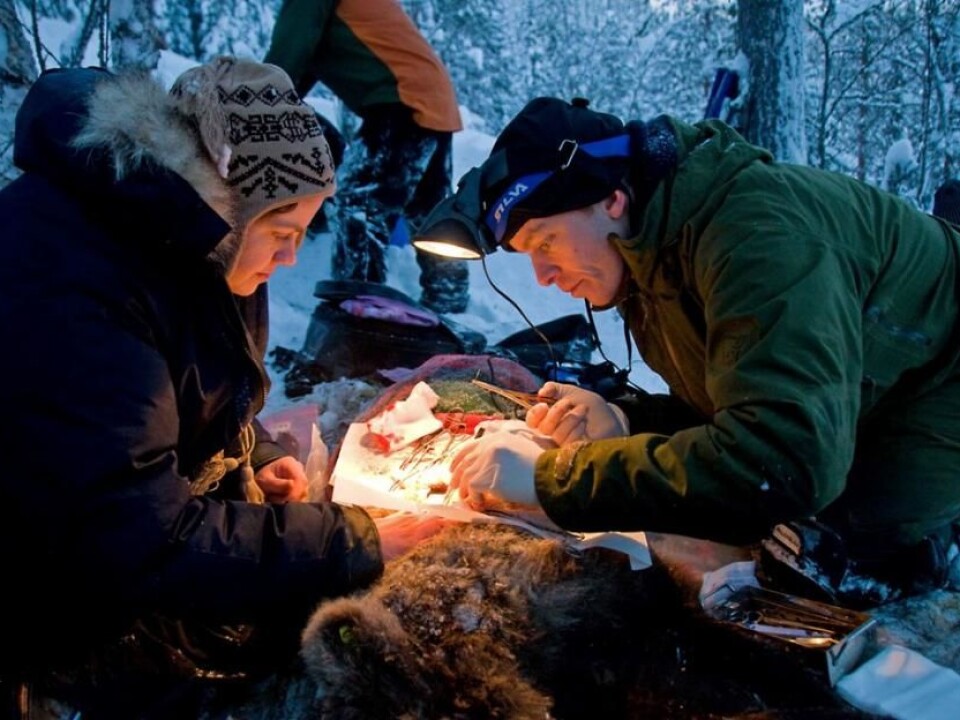
In summer, the microbiota favours fat accumulation, and in winter it favours fat burning, which will be the bear’s only source of energy during the long cold months.
Identifying this shift in bacteria is the work of the Scandinavian Brown Bear Research Project, led by Frederik Bäckhed from the University of Copenhagen, Denmark, and University of Gothenburg, Sweden. The results are published in the journal, Cell Reports.
In search of bear faeces
The treetops sway from the rotor wind as an agile little helicopter descends on its target. The bear looks up, its small eyes almost hidden in amongst all the fur. Then it breaks into a run. Within minutes, the shot of a dart gun has put the bear to sleep. Amidst the blueberries, vets rush in to check that the bear is anaesthetised and they begin to prepare to take samples.
A couple of hundred metres away, another group of scientists eagerly awaits their final “OK.” Now a carefully planned hour begins. They fall to their knees in a predefined order around the furry beast, and each sample is taken, treated, and frozen within minutes. The samples will hopefully provide insights into how the bear can overeat, become obese, and then wake up after six months of sleeping with no physical problems.
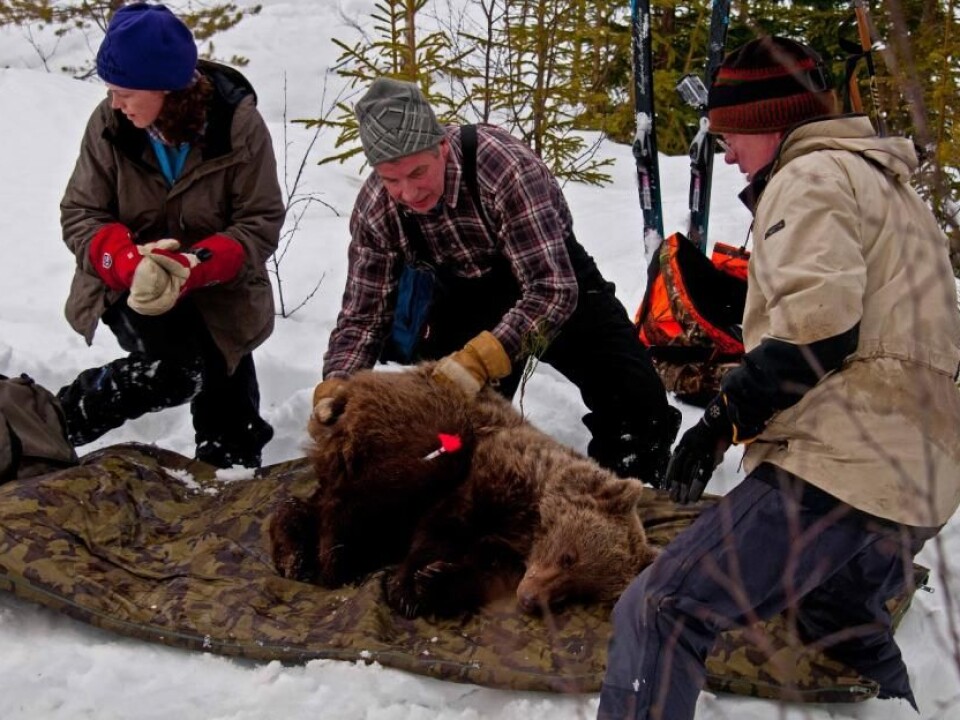
This year, there is a lot of activity around the hind region of the sleeping bear. The hunt is on for samples of intestinal microbiota. Bear faeces, in other words. While at the other end, a vet draws blood from a large vein in the neck of the animal.
Within an hour, they are done. The scientists retreat and one of the vets gives the bear an antidote, so it can return to eating its blueberries.
This bear is part of the Scandinavian Brown Bear Research Project, where each year, scientists equip a group of young wild bears with a GPS collar and catch them to take samples in summer and winter.
Read More: Brown bears vie with wolves for food
Fat bears are healthy bears
Samples from the bear show a less diverse microbiota in winter, with an increase in one particular group of bacteria. The blood work also shows increases in the various forms of fatty acids and cholesterol, which makes sense as the bear will need to survive on its fatty insulation throughout winter.
We know from humans that our gut biota changes with diet. We also know that the composition in healthy people is different to that of obese people or those with type 2 diabetes.
To understand precisely what role changing bacterial flora plays in the bear’s survival from summer to winter, the scientists feed the bear bacteria to sterile mice.
These mice contain no inherent bacteria of their own. They are an expensive tool, as they are raised in a completely sterile environment in airtight chambers, and are birthed by C-section instead of natural birth. But it’s worth it as they are brilliant controls.
The mice that were fed summer bacteria became more rounded than mice fed winter bacteria, but the differences were not particularly striking. More interestingly though, mice fed summer bacteria showed no sign of developing insulin resistance. This confirms previous studies that showed that bears show no signs of metabolic mismatches in summer.
So the bear’s summer bacteria, seem to allow both the bears and the laboratory mice to accumulate fat without the negative side effects.
In humans, obesity often leads to insulin resistance. But despite eating overwhelming amounts of sugar from a diet composed mainly of blueberries and the occasional anthill, the bear copes just fine. Sugar is taken into cells where it is converted to energy and fat as usual. And this continues no matter how fat the bear becomes.
In humans, obesity increases the likelihood that the body no longer reacts effectively to insulin. The sugar stays in the blood, leading to type 2 diabetes and other effects, such as elevated blood pressure, elevated cholesterol, and cardiovascular diseases.
But thanks to its gut bacteria, the brown bear copes with obesity and appears to be a healthy individual. Scientists now hope to learn more about this coping mechanism.
Read More: Why bears can be obese and healthy
Identified microbial strain that affects insulin sensitivity
New research in humans has identified one particular bacterial strain associated with insulin resistance. Bäckhed was a co-author of the study published in the scientific journal PLOS ONE.
Elsewhere, studies (here and here) have shown that toxins from a group of gut bacteria play a role in the development of a chronic low-grade inflammation of the fatty tissue surrounding the intestines. Low-grade inflammation is prevalent in people with obesity and can lead to the development of insulin resistance.
Unless insulin resistance is diagnosed and treated early, it can lead to a number of other obesity related illnesses like type 2 diabetes.
Bäckhed’s PLOS ONE study provided the first solid evidence that a particular strain of bacteria, Ralstonia pickettii, is a root cause of developing low-grade inflammation:
DNA traces show that R. pickettii cross the gut endothelial barrier--the one cell layer usually containing the intestinal flora--and is found in the visceral fat surrounding the intestine in healthy obese people, i.e. those not diagnosed with type 2 diabetes.
Obese people diagnosed with type 2 diabetes had 30 percent more R. pickettii DNA in faecal samples compared to non-diabetic people who were also obese.
People who have developed insulin-resistance, but are otherwise healthy also have 30 per cent more R. pickettii DNA.
Read More: “Yeti” samples are actually from bears
Mice confirm microbial influence
In order to test whether R. pickettii is a direct cause of chronic low-grade inflammation, the study authors designed an experiment with laboratory mice who had been fed fatty foods for eight weeks.
Afterwards, and for the next four weeks, the mice were assigned to three different groups: One group was fed a daily dose of living R. pickettii. The second group had a daily treatment of dead R. pickettii. Finally, the third group had a bacteria-free control feed via the gavage tube, which is a small tube inserted through the mouth all the way into the stomach. Gavage feeding is a way to make sure that the same amounts are fed to all animals.
Mice fed with either alive or dead bacteria struggled to regulate their blood sugar levels. However, only mice fed live bacteria experienced an increase in endotoxins in their blood and R. pickettii DNA in the visceral fat around their organs.
This suggests that there is a direct link between presence of R. pickettii in visceral fat, elevated blood endotoxins, and poor blood sugar regulation. Meanwhile, the mice who had only been fed dead bacteria became both fat and insulin resistant.
The study speculates that this may be due to a gut immune response to the R. pickettii toxins inside the intestines, which creates an inflammatory state.
But do you have to be fat in order for the bacteria to make a mess? It seems so, as lean mice (who had not eaten a fatty diet during the eight week pre-trial period) did not show the same trend. These lean mice were given the same three bacterial doses (alive bacteria, dead bacteria, and the control gavage feedings), and were completely unaffected. No matter which type of bacteria they received, the lean mice did not develop insulin resistance.
This shows that a fatty diet is a prerequisite for the role of R. pickettii in the development of insulin resistance. In mice, at least.
Just like humans, the mice that had been fed the fatty diet had developed “pre-diabetes”- the precursor to actual diabetes.
The risk of developing diabetes may thus be traced back to a particular bacterial strain literally ‘on the run.’ This is a new focus point for research. Next up will be more studies in humans using radioactively labelled bacteria to see how the R. pickettii manage to cross the gut epithelial barrier and move where we did not think they could—into our fat.
Knowing what role gut bacteria play in the development of insulin resistance may even allow us to design microbial cocktails to restore insulin efficiency before type 2 diabetes can develop.
Read More: Grizzly-polar bear hybrids spotted in Canadian Arctic
Bears cope with extremes – we can learn from them
Hibernating mammals eat enormous amounts of food during the summer and become grossly overweight in the process. And yet, unlike humans, they do not suffer any negative health consequences.
This makes the bears especially “helpful in raising a number of interesting hypotheses,” says Bäckhed.
Bears and other hibernators thrive in the extremes: They eat obsessively and build impressive fat layers. And yet their bodies cope just fine.
It is likely that the physiological mechanisms that allow them to regulate blood sugar while putting on so much weight are particularly visible in hibernators. And by studying bears and germ-free mice injected with bear bacteria, scientists will be able to decipher what happens in the body when fat consumption far exceeds energy requirements.
Bäckhed though, remains cautious at this stage. “It remains to be seen how transferable the findings are to humans,” he says.
Read More: Caught in the mesh: Scandinavian bears in the road network
The hibernator know-how
Bäckhed and colleagues hope to learn more about the bear’s natural, healthy obesity.
When they completed their bear study they did not yet know about the role of Ralstonia pickettii in low-grade inflammation, and so they did not look for this particular strain.
For now, they still do not know whether R. pickettii, or other bacteria working against the effect of R. pickettii, play a role in healthy obese bears. So it is one to watch in the coming years.
Understanding hibernators in this way, can provide new insights into what a body can do. Combining this with what we know from humans and laboratory animals, could one day lead to new treatments to tackle obesity.
In humans, obviously. Hibernators are doing just fine.
---------------
Read this article in Danish at ForskerZonen, part of Videnskab.dk
Inge Grønvall Revsbech is a biologist and writer. She holds a PhD in animal physiology. She was not involved in the research presented in this article.
Translated by: Inge Revsbech
